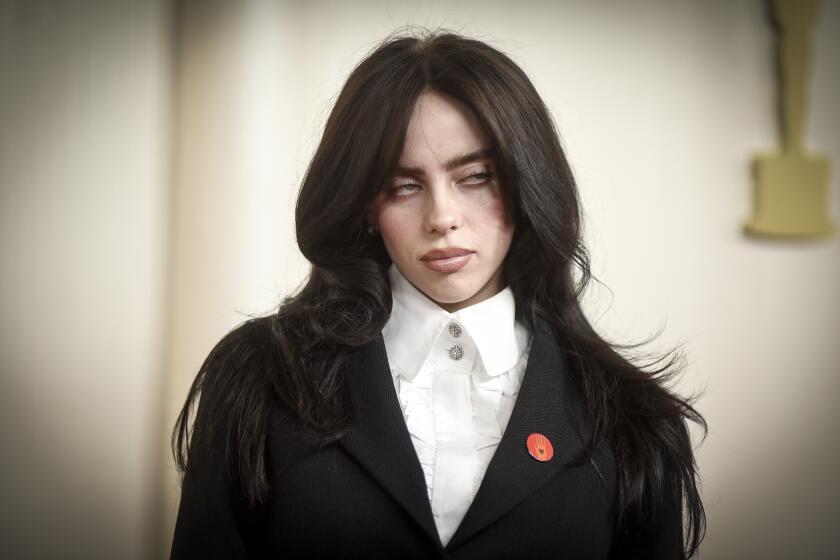Miguel ‘Anga’ Diaz, 45; Afro-Cuban Music’s Conga Drum Master
Cuban percussionist Miguel “Anga” Diaz, an acclaimed conga master who perfected a dazzling five-drum technique with a versatility that allowed him to span genres from progressive jazz to traditional Afro-Cuban standards, has died. He was 45.
Diaz, who was also a composer and arranger, suffered a heart attack Wednesday at his home in San Sadurni d’Anoia, a small town east of Barcelona, where he had recently moved in search of a more serene lifestyle. His body was discovered by a student who had gone to the home for a lesson, according to a spokesman for his label, London-based World Circuit records.
The news came as a shock in music circles, where Diaz is hailed as one of the world’s leading exponents of Afro-Cuban percussion, a complex and physically demanding discipline.
Friends who had talked to Diaz a few hours before his death said he was in good spirits with a full agenda of touring and recording, including a show with the Cuban fusion group Sintesis scheduled for that night. During a stop in London earlier this year, the musician was ebullient with new ideas and excited about future projects, said World Circuit owner Nick Gold, a co-producer of Diaz’s debut album as a bandleader, 2005’s boldly experimental “Echu Mingua.”
Gold met Diaz in Havana in 1996 during the first recording session by the Afro-Cuban All Stars, a precursor to the Buena Vista Social Club. Gold regularly called on Diaz to work on solo albums by Buena Vista alumni, including singer Ibrahim Ferrer, bassist Orlando “Cachaito” Lopez and guitarists Ry Cooder and Manuel Galban.
“After working with Anga as a conga player, no one else would do,” Gold said Friday by phone from England. “Technically, he was just extraordinary. And he seemed to have no musical barriers whatsoever.”
Jazz pianist Omar Sosa, who is also based in Barcelona and toured frequently with Diaz in his group, said the conga player had evolved far beyond his traditional instrument. For a time, recalled Sosa, Diaz even expropriated a Gymboree toy from his son because it made a unique wave-like sound the percussionist liked.
“He was always creative, that’s for sure,” said Sosa, whose upcoming CD, “Live a FIP,” features Anga on a complex of percussion instruments. “It’s astounding how many sonic colors you hear in his work. The knowledge he had, the wisdom, was just gigantic. He understood the entire language of Afro-Cuban percussion.”
Sosa spoke by phone Friday from Barcelona shortly after an emotional funeral service for Diaz that featured a performance of the heart-wrenching bolero “Toda Una Vida” (“All Life Long”) by Diaz’s brother and bandmate, Juan “El Indio.” The artist’s remains were to be cremated and his ashes sent back to Cuba, where his parents live in his childhood home.
Miguel Aurelio Diaz Zayas was born in 1961 in San Juan y Martinez in Pinar del Rio province. He inherited his nickname from his father, Aurelio Diaz Fernandes, the original Anga.
He showed prodigious talent as a child and started formal percussion studies by the age of 10. Four years later, he earned a scholarship to the National School of Art in Havana, where he also had the chance to work with renowned Cuban conguero Tata Guines and drummer Guillermo Barretto.
After college, he launched his professional career with the avant-garde group Opus 13, touring and recording with them for nine years, mostly in the 1980s. It was a period of intense experimentation in Cuban dance music, a prelude to the historic explosion of Afro-Cuban dance bands in the 1990s.
When the explosion came, Diaz was at the epicenter as percussionist with Irakere, Cuba’s preeminent progressive band, led by pianist Chucho Valdes. Diaz had the challenging task of replacing the band’s original percussionist, the late Jorge “El Nino” Alfonso.
“Those were big shoes to fill, but Anga pulled it off,” said Raul Pineda, a former member of Valdes’ quartet who lives in Los Angeles. “It was difficult both musically and physically, because of Irakere’s challenging arrangements and because in Cuba, unlike here, bands would play for three hours straight.”
It was in Irakere that Diaz perfected the five-conga technique used by his predecessor.
“He could do things [on congas] that could only be dreamed of before he came on the scene,” said Paul de Castro, an expert in Afro-Latin music who teaches at Cal State L.A. “Anga was one of the innovators in conga technique.”
Diaz went on his own in 1994, recording “Pasaporte” with his conga hero, Guines. He set up a home in Paris, where he married, started a family and eventually became a French citizen, dividing his time between France and Cuba.
In 1996, he joined Roy Hargrove’s band Crisol, recording on the U.S. trumpeter’s Grammy-winning album, “Habana.” He went on to record with a diverse set of artists, from the biting debut album by Cuba’s hip-hop trio Orishas to graceful works by Buena Vista veterans Ruben Gonzalez and Omara Portuondo.
After moving to Barcelona in 2003, Diaz kept up an intense schedule of work. A week before his death, Diaz appeared in Barcelona with his new ensemble, fusing popular Brazilian music with Afro-Cuban jazz. He also recently formed a trio with Cachaito and flamenco pianist Chano Dominguez. And the new live album, recorded by Radio France, is due for release Oct. 10 on Sosa’s Ota Records.
In addition to his father and brother, Diaz is survived by his mother, Maria Luisa Zayas Hernandez; twin 12-year-old daughters, Lisa and Naomi of Paris; and their half sister, Yanira, 22, of Miami.
More to Read
The biggest entertainment stories
Get our big stories about Hollywood, film, television, music, arts, culture and more right in your inbox as soon as they publish.
You may occasionally receive promotional content from the Los Angeles Times.






